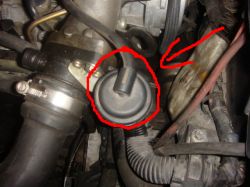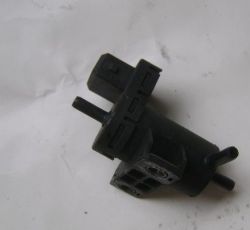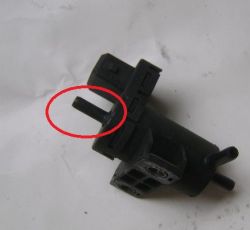FAQ
TL;DR: Megane II 1.9 dCi power loss and a ~3,000 rpm cap often trace to a stuck vacuum solenoid; OEM costs ~PLN 500. "Check vacuum from the pump." Replacing the anti‑shudder flap control restores power and revs. [Elektroda, kamiloskop, post #17130915]
Why it matters: This helps Renault Megane II 1.9 dCi owners quickly diagnose and fix choking/no‑rev issues tied to the anti‑shudder flap vacuum control.
Quick Facts
- Symptom profile: no power and won’t rev beyond ~3,000 rpm; unplugging the membrane’s vacuum line restores power. [Elektroda, tytan53, post #17125069]
- Vacuum logic: the anti‑shudder flap should see vacuum only at engine shutdown; vacuum at idle indicates a fault. [Elektroda, sulof1601, post #17125897]
- Fault effect: vacuum at start pulls the diaphragm, closes the flap, and the engine “suffocates.” [Elektroda, tytan53, post #17126510]
- Valve spec: the control solenoid has three ports—vacuum in, vacuum out, and a vented filter; misrouting causes wrong behavior. [Elektroda, szachu41, post #17127776]
- Costs: reported OEM ~PLN 500; aftermarket ~PLN 100; used parts are a lottery. [Elektroda, kamiloskop, post #17130915]
What causes a Megane 1.9 dCi to lose power and stop at ~3,000 rpm?
Constant vacuum reaches the anti‑shudder flap at idle. The diaphragm closes the intake flap, choking airflow. That limits revs and power. The poster observed vacuum on start, a closing flap, and immediate suffocation. Removing that incorrect vacuum path restores airflow and power. Replace the stuck control solenoid to stop vacuum during running. This restores normal rev range and drivability. [Elektroda, tytan53, post #17126510]
What does the “air stabilizer membrane” (anti‑shudder flap) do?
It’s the intake shut‑off used to stop the engine smoothly. The flap closes during shutdown to prevent shudder. During normal driving, the flap should stay open and see no vacuum. If it closes while running, the engine will stumble and lose power. That points to a control fault rather than normal behavior. [Elektroda, szachu41, post #17125666]
Should there be vacuum at the flap while idling or driving?
No. “Negative pressure should appear in the moment of extinguishing the car and never again.” If you measure vacuum at idle, diagnose the control solenoid and its plumbing. That behavior will close the flap and cause choking or a hard 3,000 rpm cap. [Elektroda, sulof1601, post #17125897]
Where is the control solenoid located on this engine?
Trace the small vacuum hose from the anti‑shudder flap actuator. Follow it to the other end. The vacuum control solenoid sits there. This method avoids guesswork and ensures you find the exact valve driving your diaphragm actuator. [Elektroda, sulof1601, post #17127110]
How do I identify the three ports on the vacuum solenoid?
The valve has three stubs: vacuum input, vacuum output to the diaphragm, and a vented filter. If hoses are misplaced, the valve may pull vacuum at the wrong time. Confirm port orientation before testing or replacement to avoid misdiagnosis and fresh faults. [Elektroda, szachu41, post #17127776]
Is that small protruding “spindle” port supposed to be unconnected?
Yes. That little protruding port is not plumbed to a hose on this setup. The forum reply confirmed it being unconnected is correct, so don’t cap it. Leave it as is after you verify the other two lines are routed correctly. [Elektroda, coperfild, post #17127522]
How can I test the valve quickly at home?
Use this simple check:
- Remove the valve and note hose positions.
- Blow through the valve without power applied.
- If air passes freely, the valve is jammed open—replace it.
This quick test detects a stuck solenoid that applies vacuum constantly and closes the flap during running. [Elektroda, sulof1601, post #17128284]
Can I bypass the valve briefly to confirm the fault?
Yes. Connect the two tubes directly to bypass the solenoid and test. If the engine then revs past ~3,000 rpm, the solenoid or its control is at fault. Restore original plumbing after the test and proceed with proper repair or replacement. [Elektroda, kamiloskop, post #17128013]
What else should I check if vacuum appears at idle?
Verify hose routing first. Then check wiring harness continuity to the solenoid. If both check out, suspect a failed solenoid. As an edge case, the controller could be faulty, but test it last. Follow that order to avoid unnecessary parts swaps. [Elektroda, szachu41, post #17127776]
Do I need to replace the MAP sensor again for this symptom?
Not for this fault pattern. In the reported case, replacing the vacuum control valve restored full power and responsiveness. The MAP sensor was not the cause of the choking or 3,000 rpm ceiling here. Focus on the flap solenoid and its vacuum supply first. [Elektroda, tytan53, post #17142088]
How much does the control valve cost, and which should I buy?
One member reported OEM around PLN 500 and aftermarket around PLN 100. Used units are a lottery. Choose new OEM for longevity or a reputable aftermarket for cost savings. Inspect vacuum lines and pump output during replacement to prevent repeat issues. [Elektroda, kamiloskop, post #17130915]
Should I check the vacuum pump output during diagnosis?
Yes. Ensure the vacuum pump supplies adequate vacuum before blaming electronics. A participant specifically advised verifying pump vacuum. Use a hand vacuum gauge (e.g., Mityvac) to confirm output and isolate a weak pump from a stuck solenoid. [Elektroda, kamiloskop, post #17130915]
After fixing, I hear a gentle whistle below 2,000 rpm—is that normal?
The poster noted a mild whistle below 2,000 rpm and power onset around 2,200 rpm after the repair. Performance otherwise improved, suggesting expected turbo spool behavior. Monitor for growth in noise or new power loss, which could indicate an intake leak. [Elektroda, tytan53, post #17142088]
What happens if the vacuum hoses are swapped on the solenoid?
Misrouting can cause the flap to close at idle or fail to close at shutdown. Identify the vacuum input, output, and vent correctly. Reversing lines is a common source of “always‑on vacuum” and choking behavior on start. [Elektroda, szachu41, post #17127776]
Could the ECU be commanding vacuum constantly?
A responder judged the controller unlikely here and pointed to a damaged valve instead. Rule out the solenoid and plumbing first. Consider ECU control only after those pass tests, since it is a rarer failure mode in this symptom set. [Elektroda, sulof1601, post #17126519]






